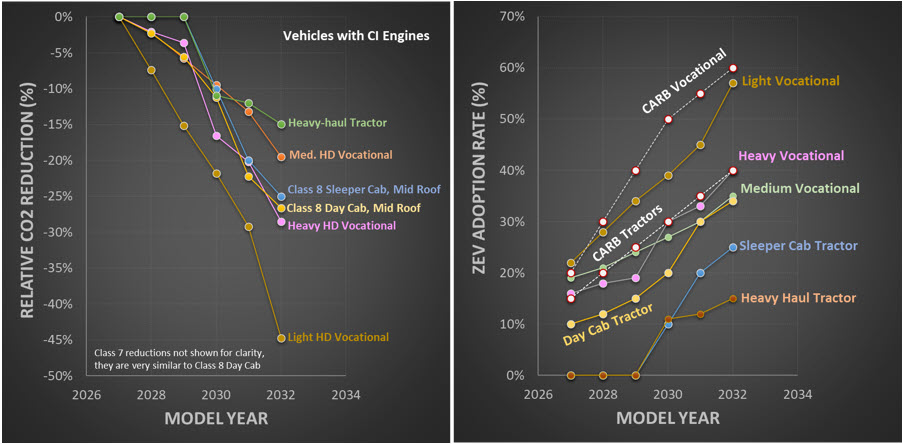U.S. EPA Phase 3 Greenhouse Gas Proposal for Heavy-Duty Vehicles
From 2027 to 2032, 45% reduction in CO2 emissions for light vocational vehicles and 25% for Class 8 sleeper cabs. Over half of light vocational and a quarter of sleeper cabs expected to be ZEVs by 2032.
On April 12, 2023, the U.S. EPA announced the Phase 3 proposal for reduction of greenhouse gas emissions from heavy-duty vehicles. This is a lengthy proposal, with much more details than can be posted here. Download the summary document for more details.
Proposed CO2 standards and estimated ZEV adoption
The proposal establishes new CO2 standards for MY 2028 through MY 2032 for heavy-duty vocational vehicles and tractors.
This is a technology neutral standard i.e. an OEM can choose any powertrain and fuel mix to meet the CO2 standards. However, unlike previous regulations which set CO2 standards and then estimate the expected uptake of alternative powertrains (such as battery electric or fuel cell vehicles), this proposal first estimates the ZEV adoption and then sets CO2 standards accordingly.
The EPA has provided incremental cost estimates for vehicles and charging for ZEVs (relative to diesels) and the payback time due to reduced operational costs. The payback time is then used to assess ZEV uptake. Finally, CO2 standards for MY 2028 – 2032 are set keeping the ICE efficiency fixed at MY 2027 levels and assuming that fleet CO2 reductions occur through increased ZEV share.
As shown in the chart here, ZEVs are expected to occupy 15 – 57% of the fleet share by 2032, depending on application. Relative to MY 2027, CO2 emissions will have to reduce by 15 – 45%. As expected, higher rates of ZEV adoption and CO2 reduction are seen for lighter vehicles.

Benefits of this rule
The Phase 3 rule is expected to cumulatively reduce tailpipe GHG emissions by 2.3 billion tons over 2027 – 2055.
The reduced fuel consumption will also result in reduced criteria pollutants. In 2055, emissions of NOx are estimated to reduce by 28%, PM2.5 by 39%, VOC by 37%, and SO2 by 31%.
The present value of net benefits to society are estimated at ~ $320 billion through 2055, more than 5 times the cost in vehicle technology and associated electric vehicle supply equipment (EVSE) combined.
Sign up here to receive such summaries and a monthly newsletter highlighting the latest developments in transport decarbonization
5-Min Monthly
Sign-up to receive newsletter via email
Thank you!
You have successfully joined our subscriber list.
